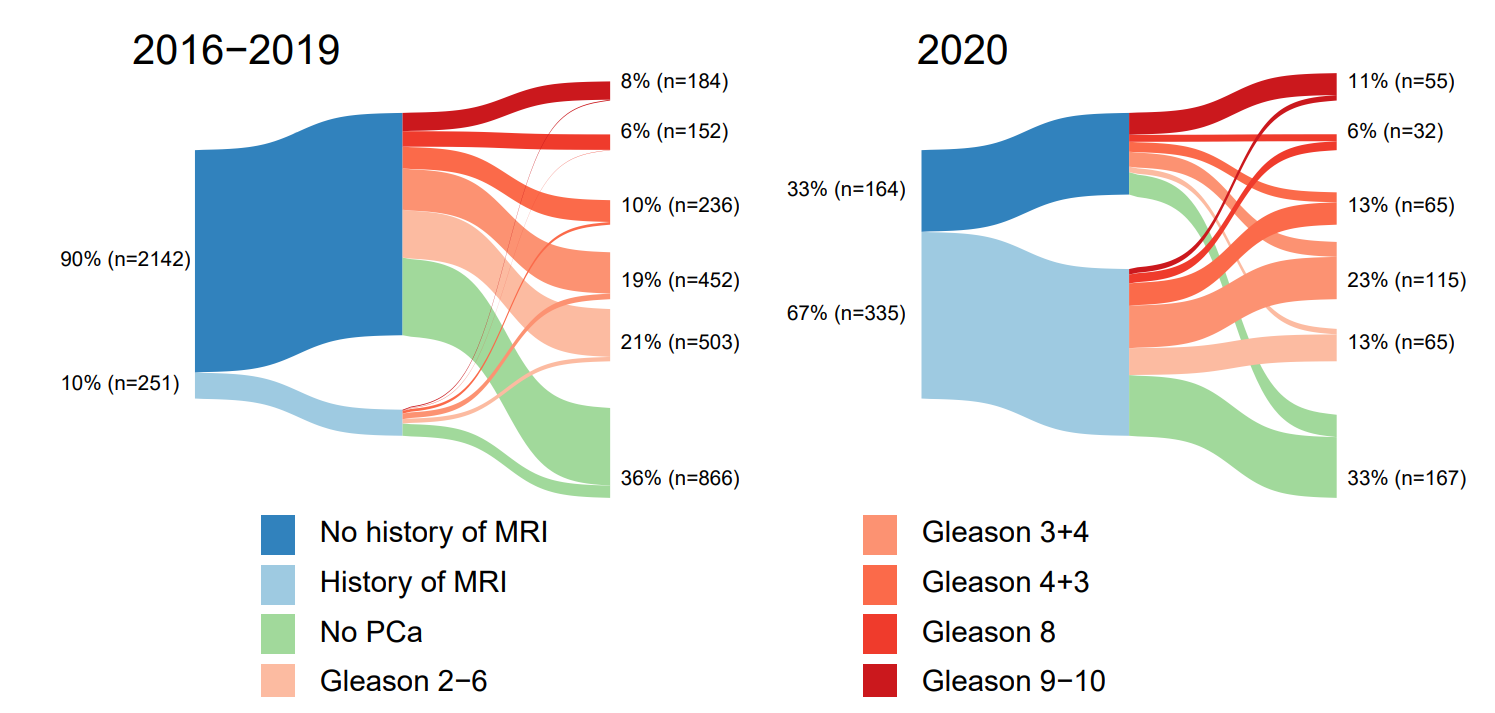Back
Poster, Podium & Video Sessions
Podium
PD03: Prostate Cancer: Epidemiology & Natural History I
PD03-01: MRI as first investigation in men with elevated PSA. Population-based cohort study
Friday, May 13, 2022
7:00 AM – 7:10 AM
Location: Room 245
David Robinsson*, EKSJÖ, Sweden, Hans Garmo, Uppsala, Sweden, Delshad Nasrollah, Jönköping, Sweden, Tiago Bonde Miranda, Malmö, Sweden, Pär Stattin, Uppsala, Sweden

David Edward Robinsson, MD
Department of Urology, Jonkoping, Sweden
Podium Presenter(s)
Introduction: In randomized controlled trials of men with elevated PSA, MRI before prostate biopsy resulted in fewer insignificant cancers defined as Gleason Score =6 while the detection of significant cancers defined as Gleason Score =7 increased. The aim of this study was assessed if these results from RCT’s can be reproduced in clinical practice including all men with elevated PSA in a region.
Methods: Data on all PSA values between 2010-2020 and all prostate biopsies performed in 2005-2020 and use of MRI were collected for all men in the region of Jönköping. These data were linked to The National Prostate Cancer Register. Before 1 January 2020 only select cases underwent MRI whereas after that, there was unlimited access to MRI in this region. Results for all men who underwent biopsy 2016-2019 when prior use of MRI was low was compared to all men who underwent biopsy in 2020 when usage of MRI was high. Outcome was number of men who underwent prostate biopsy, benign or malignant pathology report, and distribution of Gleason score.
Results: First investigation in men with elevated PSA was 66 MRIs in 2016 and 681 MRIs in 2020. Out of these 681 MRIs, 317 were performed on men who had undergone at least one previous biopsy set with negative result before MRI, their risk of cancer was 9 % on biopsy after MRI. In contrast, 51 % of biopsy naive men who underwent an MRI had cancer on subsequent biopsy. The number of men who performed a biopsy as first investigation was 630 in 2016 and 190 in 2020. The median PSA was 8.5 ng/mL in 2016-2019 vs 8.0 in 2020.
In 2020, 499 biopsies were performed vs an average of 598 in 2016-2019. The number of biopsies without cancer was 167 for 2020 vs an average of 216 in 2016-2019. There was no difference in the number of significant tumors between 2020 and 2016-2019, 267 in 2020 vs an average of 256 in 2016-2019. In contrast, there was a decrease from an average of 126 insignificant cancers per year in 2016-2019 vs. 65 in 2020, (figure).
Conclusions: When MRI became available without any limitations in our region, the number of prostate biopsy sessions decreased by 20%, the numbers of significant tumors remained the same, and the number of insignificant cancers decreased by 48%.
Source of Funding: Stiftelsen fonden klinisk cancerforskning i Jönköping

Methods: Data on all PSA values between 2010-2020 and all prostate biopsies performed in 2005-2020 and use of MRI were collected for all men in the region of Jönköping. These data were linked to The National Prostate Cancer Register. Before 1 January 2020 only select cases underwent MRI whereas after that, there was unlimited access to MRI in this region. Results for all men who underwent biopsy 2016-2019 when prior use of MRI was low was compared to all men who underwent biopsy in 2020 when usage of MRI was high. Outcome was number of men who underwent prostate biopsy, benign or malignant pathology report, and distribution of Gleason score.
Results: First investigation in men with elevated PSA was 66 MRIs in 2016 and 681 MRIs in 2020. Out of these 681 MRIs, 317 were performed on men who had undergone at least one previous biopsy set with negative result before MRI, their risk of cancer was 9 % on biopsy after MRI. In contrast, 51 % of biopsy naive men who underwent an MRI had cancer on subsequent biopsy. The number of men who performed a biopsy as first investigation was 630 in 2016 and 190 in 2020. The median PSA was 8.5 ng/mL in 2016-2019 vs 8.0 in 2020.
In 2020, 499 biopsies were performed vs an average of 598 in 2016-2019. The number of biopsies without cancer was 167 for 2020 vs an average of 216 in 2016-2019. There was no difference in the number of significant tumors between 2020 and 2016-2019, 267 in 2020 vs an average of 256 in 2016-2019. In contrast, there was a decrease from an average of 126 insignificant cancers per year in 2016-2019 vs. 65 in 2020, (figure).
Conclusions: When MRI became available without any limitations in our region, the number of prostate biopsy sessions decreased by 20%, the numbers of significant tumors remained the same, and the number of insignificant cancers decreased by 48%.
Source of Funding: Stiftelsen fonden klinisk cancerforskning i Jönköping


.jpg)
.jpg)